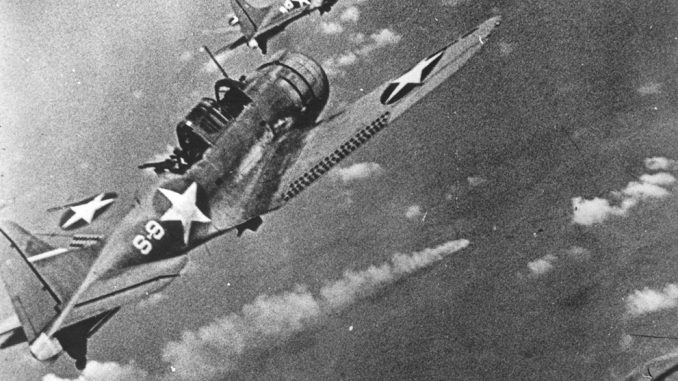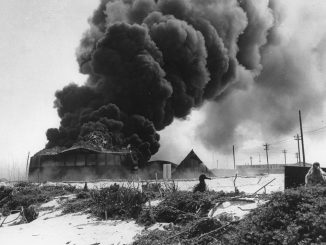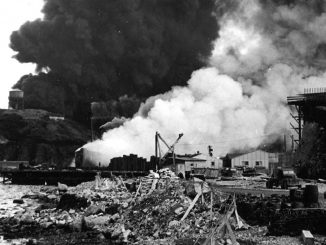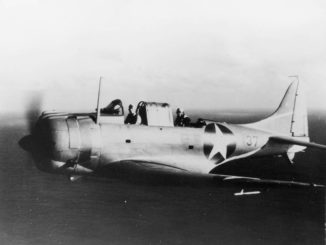
When word of the American attack in the Kido Butai, and the subsequent destruction of the Kaga, Akagi and Soryu, made its way back to Admiral Yamamoto aboard his flagship Yamato, he was stunned. Information from captured American aviators also revealed the array of forces that the Japanese were up against for the first time – three carriers operating in two groups. Electing to re-organise his forces, Yamamoto temporarily suspended the invasion of Midway, ordering the attack transports to withdraw to the west, and ordered the two carriers involved in the Aleutians operation to head south with all possible speed to reinforce Nagumo’s Kido Butai. As part of this redeployment the 7th Cruiser Division – Kumano, Suzuya, Mogami and Mikuma, plus destroyers Asashio and Arashio – was ordered to close on Midway and carry out a bombardment. Rear-Admiral Takeo Kurita was in charge, his flag flying from the Kumano.
At the time Kurita received his new orders his ships were 400 miles from Midway, necessitating a high-speed run in to the island in order to deliver the bombardment before the inevitable attack by American aircraft. Even so the shelling would have to be delivered in daylight, a highly dangerous undertaking with US Navy carriers in the vicinity. The cruisers went to maximum speed and soon left their escorting destroyers behind. Meanwhile the submarine I-168 was ordered to deliver her own bombardment to keep the island occupied whilst Kurita approached.
In the early hours of the 5th of June, more messages reached Yamamoto – these making clear the hopelessness of the Japanese position. The captain of the Akagi requested permission to scuttle his ship, her situation being completely hopeless. This request seems to have shocked Yamamoto, who soon after ordered the cancellation of the Midway operation and the recall of all forces. However, the message that was intended for Kurita’s 7th Cruiser Division was mistakenly sent to the 8th Cruiser Division, a mistake that was not rectified for several hours. By the time the recall message was received at about 0200 on the 5th, Kurita was just 90 miles from Midway.
Collision at Sea
Just moments after changing course to withdraw to the east, a lookout aboard the Kumano spotted the silhouette of the submarine Tambor. Orders for an emergency turn were flashed to the cruisers astern but the Mikuma, third in line, made a 90-degree turn instead of a 45-degree turn as ordered. Mogami, last in line, turned as ordered but soon the shape of the Mikuma ahead loomed in the darkness ahead, too late for any kind of evasive manoeuvre. Mogami rammed her sister just aft of the bridge, puncturing Mikuma’s oil tanks and causing fuel oil to leak into the sea. Mogami’s bow was badly crushed, almost all the way to her forward turret, which severely curtailed her speed. Kurita assessed the situation and, aware that he had been spotted by the Tambor and that American air strikes could be expected soon after dawn, elected to detach the destroyers Asashio and Arashio to escort the cripples whilst the Kumano and Suzuya escaped at high speed.
The Tambor’s report of ‘many ships’ so close to Midway brought the predictable response – it suggested that the Japanese might still be trying to force a landing. Other American submarines in the area were ordered to close in to protect Midway, and bombers on the island were readied for attacks. To the north, Spruance copied the dispatch and turned his two remaining undamaged carriers south, ready to assist if needed. Twelve B-17s took off from Midway just minutes after the message was received, but they failed to find the twin cripples and returned empty-handed. Soon afterwards a PBY made contact and gave an accurate position report but identified the vessels as ‘two battleships’ – a mistake which was to cause considerable confusion for the next two days.
Next to launch from Midway were six SBDs and six SB2Us from VMSB-241, lead by Capt. Marshall Tyler. The Marines soon spotted a heavy oil slick and followed it all the way to the Japanese cruisers. The SBDs elected to attack the Mogami, but all of their bombs missed due to the cruiser’s heavy anti-aircraft fire. The SB2Us, having been delayed after sighting and investigating a submarine, arrived a few minutes later and selected the Mikuma as their target. Again anti-aircraft fire was intense and the leading Vindicator, flown by Capt. Richard Fleming, was hit and ploughed into the sea. A myth has persisted the Fleming crashed his aircraft onto the Mikuma, but in fact his SB2U crashed into the sea not far from the cruiser. Shortly after the Marines departed, eight B-17s attacked the two cruisers with limited results. Mogami and Mikuma limped on.
Spruance meanwhile had to contend with several possible targets. The report of ‘two battleships’ 125 miles from Midway (actually Mogami and Mikuma) was soon followed by an accurate report of ‘two cruisers’ (Kumano and Suzuya) further to the west of Midway , but the most enticing was a report of a ‘burning carrier, 2 battleships, 3 cruisers’ to the west of Task Force 16. This was the Hiryū, still afloat and potentially a threat. Spruance decided to attack it rather than the reported ‘battleships’. This triggered a dispute within Spruance’s staff over which bombs the SBDs should carry – Capt. Miles Browning, Spruance’s chief of staff, wanted heavy 1,000lb bombs, a marginal prospect for a target 270 miles away given the SBD’s limited fuel capacity. McCluskey, Gallaher and Shumway argued against this and Spruance agreed, delaying the launch until the distance to the target had closed and substituting 500lb bombs instead. The strike was not launched until 1500.
By this time, the Hiryū had already slipped beneath the waves of her own volition, unseen by either Japanese or American eyes. The only ship in the vicinity was the destroyer Tanikaze, which had been sent back to search for survivors and if necessary deliver the coup de grace on the carrier. Whilst engaged in this task the destroyer was bombed by B-17s which mistakenly reported the little ship as a ‘cruiser’. The Enterprise strike flew out 315 miles without finding a target, but on the return leg they came across the Tanikaze. One squadron of SBDs attacked, but thanks to superb ship-handling none of the bombs hit home, and the only damage sustained by the plucky destroyer was due to near misses that killed six of her crew. One of the attacking SBDs was shot down by Tanikaze’s anti-aircraft crews. The bombers returned to their ships as darkness was falling, necessitating the switching on of each carrier’s lights to bring them in safely. Meanwhile, the two damaged cruisers and their escort continued west at 12 knots through the night.
Strike
First thing the following morning, at 0500, a search of 18 SBDs was launched from the Enterprise to cover the area to the west of Task Force 16. One of these aircraft sighted the Mikuma and consorts about 130 miles away, but the contact report was garbled in transit and was received by Spruance as a cruiser, 3 destroyers and carrier. A second SBD accurately reported the presence of the cruisers but with a different position, which suggested two different formations of enemy ships in the vicinity. The Hornet launched a strike of 28 SBDs supported by 8 F4Fs. Shortly after their departure, the erroneous report of a carrier was corrected leaving the Hornet group to concentrate on any surface warships they encountered. They came across the Mogami and Mikuma two hours after launch. The pilots identified Mikuma as a battleship – the Mogami was now slightly shorter than her sister having crushed her bow, which presumably caused the confusion. The SBDs gained good attack position and rolled in, claiming half a dozen hits. Mogami took the brunt, suffering a direct hit on her number 5 turret which caused heavy damage to the stern of the ship. Another bomb struck near her torpedo stowage area, but her damage control officer had jettisoned the volatile torpedoes the day before and damage there was minimal. Mikuma also took two hits which caused severe damage, and the Asashio took a damaging hit on her stern area. One Dauntless was shot down.
The Enterprise strike followed at 1045 – 31 SBDs, 12 F4Fs, plus 3 TBDs with orders not to attack if there was any sign of life amongst the target’s AA crews. This strike had orders not to attack the cruisers, but instead concentrate on the reported battleship contact thought to be a few miles ahead. This strike sighted Mogami and Mikuma but continued west, searching for the ‘battleship’. After a futile search, the SBDs turned back to go after the original group – by now the only Japanese ships within range. This latest attack concentrated on the Mikuma, which suffered five more hits by 1,000lb bombs, some of which caused terrible damage. The cruiser’s torpedo area was struck and several of the ‘fish’ exploded – Mikuma’s damage control team having elected not to jettison these weapons as Mogami’s had. One SBD attacked the Mogami and struck her amidships, causing more grievous damage. Arashio and Asashio both suffered a thorough strafing attack by the F4Fs.
A second Hornet strike was launched at 1445. By this time Task Force 16 had closed the enemy to the point that pilots at altitude could see both their own carriers and the burning enemy formation simultaneously, they were so close. In this attack the Mikuma again bore the brunt, being hit by as many as six 1,000lb bombs which left the cruiser a wreck from stem to stern. Mogami suffered another hit, and the Arashio was also hit on the stern – this bomb killed several Mikuma survivors that the destroyer had picked up. Spruance, still unsure of the identity of the targets, sent two SBDs with photographers to finally make a positive identification of the ships. These planes took detailed shots of the now derelict Mikuma, which were developed the next day and positively revealed her identity as a Mogami-class cruiser. Mikuma finally succumbed to her injuries after sunset and sank.
Spruance continued to chase the Mogami until it became clear that she was entering the umbrella of Japanese bombers based on Wake. Mogami escaped to Truk, where she was patched up and sent back to Japan for extensive repairs that lasted 8 months. She was eventually converted into a hybrid cruiser-carrier, her shattered aft turrets replaced with a small flight deck capable of housing a dozen seaplanes. Task Force 16 then broke off to head to a fuelling rendezvous, and eventually, Pearl Harbor. The Battle of Midway was over.






Your blog is great, keep up the good work!
Das Lesen Ihres Artikels hat sehr viel Spaß gemacht. Bobette Kale Haimes